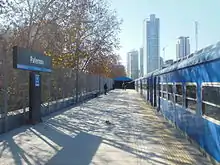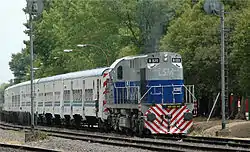San Martín Line
The San Martín line is a 70-kilometre (43 mi), 22-station commuter rail service in the metropolitan area of Buenos Aires, Argentina. The San Martín line operates from the city-centre terminus of Retiro north-west to Doctor Cabred in Luján Partido[3] along a broad gauge line built by the British-owned Buenos Aires and Pacific Railway.
 A CSR SDD7 train leaving Villa Devoto station. | |||||
| Overview | |||||
|---|---|---|---|---|---|
| Service type | Commuter rail | ||||
| Status | Active | ||||
| Locale | Buenos Aires Province | ||||
| Predecessor | BA & Pacific R. | ||||
| First service | 1948 | ||||
| Current operator(s) | Trenes Argentinos | ||||
| Former operator(s) | Corredores Ferroviarios | ||||
| Annual ridership | 17,983,125 (2019)[1] | ||||
| Website | San Martín Line | ||||
| Route | |||||
| Start | Retiro | ||||
| Stops | 22 | ||||
| End | Dr. Cabred | ||||
| Distance travelled | 72.5 km | ||||
| Average journey time | 75' [2] | ||||
| Service frequency | 15' | ||||
| On-board services | |||||
| Class(es) | Standard class only | ||||
| Technical | |||||
| Track gauge | 1,676 mm (5 ft 6 in) | ||||
| |||||
The line is currently operated by State-owned company Operadora Ferroviaria Sociedad del Estado (SOFSE) after the Government of Argentina rescinded the contract with former operator Corredores Ferroviarios in March 2015. Passenger numbers in 2015 beat historical records for the line, which has been largely attributed to the newer rolling stock and refurbished stations.[4]
History
Background


The first line had been built and operated by the Buenos Aires and Pacific Railway, a British-owned company. The original projects included a railway to connect Argentina and Chile, but instead the BAPR focused on getting access to Buenos Aires. When the Government of Argentina granted concession to build the line, the company opened a 100-km length Mercedes−Palermo segment.
Ferrocarriles Argentinos
On 13 February 1947, the Government of Argentina acquired the Buenos Aires and Pacific Railway, changing its name to Ferrocarril General San Martín one year later when the entire Argentine railway network nationalised by Juan Perón's administration. Immediately after nationalisation, there was a project to electrify the line, however this never came to fruition.
During the 1960s the line was restructured, renewing its rolling stock. Therefore, the steam locomotives of San Martín line were replaced by diesel ones. The old coaches made of wood were also replaced by new wagons manufactured in Fiat Ferroviaria (then Materfer) factory in Córdoba Province.
In the 1970s the modernisation continued, renewing signals and rail tracks. In addition, most of the stations were remodelled while the orange colour was adopted to identify the line.
In 1978 a restructuring of the San Martín line was carried out by the de facto Military Government, so the terminus was set in Pilar, Buenos Aires Province. From that point on, Doctor Cabred (former terminus) and intermediate stop Manzanares were used for long-distance services exclusively, something which was reverted in later years.
Privatisation: Metropolitano
With the privatisation of the entire rail network led in the early 1990s by President Carlos Menem, Ferrocarriles Argentinos ceased to operate metropolitan services. A new State-owned transitional company, Ferrocarriles Metropolitanos S.A., was created to operate those services until they were privatised.
On 1 March 1994, private company Metropolitano (TMS) took over the line, which it operated until 7 January 2005, when the contract was revoked by the Government of Argentina. In spite of the large government subsidies received by TMS, a serious decline in the standard of their rail services has led to the original concession being revoked and the service was taken over by the consortium UGOFE.[5]
Transition
With the line managed by UGOFE, several projects were announced to improve the San Martín line services, with an estimated 36 million passengers transported yearly and which were seeing an annual increment of 15% in ridership. In 2008 the Government of Argentina announced that the electrification using overhead lines for the whole system was to be started in June 2008. The project also included a new maintenance yard, new tracks for the entire line with all level road crossings to be eliminated and replaced with bridges and tunnels. .[6][7] New rolling stock consisting of 24 diesel-electric CSR SDD7 locomotives and 160 coaches arrived from China to serve the line, which raised questions about the line's electrification.[8]
On February 12, 2014, the operation of San Martín Line was granted to private company Corredores Ferroviarios.[9][10] In April of the same year the San Martín line completed the modernisation of its entire fleet, putting into service 24 CSR SDD7 diesel locomotives and 160 coaches acquired from Chinese company CSR.[11][12] The units had been bought in 2008 but they were unable to run so the stations had to modify their platforms for the new coaches. Once works were concluded, the Chinese trains made their debut in Argentina.[13] The new rolling stock completely replaced the Materfer trains built in the 1960s and 1970s.[14]
Renationalisation
State-owned company Operadora Ferroviaria Sociedad del Estado took over Belgrano Sur and Roca (operated by Argentren) and Mitre and San Martín (operated by Corredores Ferroviarios) lines after the Government of Argentina rescinded the contracts signed with both companies on March 2, 2015. The contract terms specified that the concession could be cancelled with no right to claim compensation.[15] The agreements had been signed in February 2014, committing Argentren and Corredores Ferroviarios to operate the lines.[16][17][18]
In December 2014, plans were made between the Ministry of the Interior and Transport and City of Buenos Aires to elevate the entire line using a new viaduct from La Paternal station to the existing viaduct at Palermo station, together with a similar project for the belgrano Sur Line. Both governments cited benefits such as the improvement of road traffic and rail frequencies as reasons for building the 4.9 km viaduct.[19]
Electrification

The electrification of the San Martín line has been an ongoing issue, especially given that it is the only broad gauge line in Buenos Aires not to be electrified. Interest in electrifying the line came about as early as 1907 when it was still part of the Buenos Aires and Pacific Railway. More concrete plans emerged in 1947 which included elevating the track through the centre of the city, however, with the nationalisation of the railways in 1948, these plans were shelved.[20]
By 1987, these plans were revisited and Ferrocarriles Argentinos signed a contract with the Soviet company Tecnostroyexport to use 25 kV AC railway electrification like that recently installed on the Roca Line, with the difference that electric locomotives would be used to pull the existing carriages instead of purchasing new Japanese Electric Multiple Units like on the Roca Line. The collapse of the Soviet Union and economic problems in Argentina slowed the plans down and the privatisation of the railways in 1993 ultimately led to its cancellation.[20]
The electrification of the line was not discussed again until 2008 when the Government of Argentina announced that electrification using overhead lines for the whole system was start in June 2008.[6][7] In 2014, 24 CSR SDD7 diesel locomotives and 160 coaches acquired from Chinese company CSR were put into service, seemingly putting any electrification plans on hold,[11][20] but that same year the Minister of the Interior and Transport Florencio Randazzo stated that the project was still on the table.[21] Similarly, in 2014 when the construction of a new 4.9 km viaduct through the centre of the city was announced (similar to the one proposed in 1947), the renders presented showed overhead lines along the viaduct.[19] Similarly, the Red de Expresos Regionales plan from the City of Buenos Aires showed the line as already being electrified.[22]
The national government announced in September 2015 that China Railway Construction Corporation was carrying out a feasibility study to assess the electrification of the line.[23] A month earlier, the Ministry of the Interior and Transport had announced the possibility of financing the line's electrification through the Inter-American Development Bank.[24] Presumably, the diesel-electric rolling stock would be moved to other broad gauge diesel services in the country.
The railway line was closed May 2018 to July 2019, from Retiro to Villa del Parque, as a new viaduct was being installed from Palermo Station to La Paternal to eliminate 11 busy road crossings. It is currently not finished (July 2019) but the trains run the whole line, without stopping at Villa Crespo (Chacarita) and Paternal.
Services
| San Martín Line | |||||||||||||||||||||||||||||||||||||||||||||||||||||||||||||||||||||||||||||||||||||||||||||||||||||||||||||||||||||||||||||||||||||||||||||||||||||||||||||||||||||||||||||||||||||||||||||||||||||||||||||||||||||||||||||||||||||||||||||||||||||||||||||||||||||||||||||||||||||||||||||||||||||||||||||||||||||||||||||||||||||||||||||||||
|---|---|---|---|---|---|---|---|---|---|---|---|---|---|---|---|---|---|---|---|---|---|---|---|---|---|---|---|---|---|---|---|---|---|---|---|---|---|---|---|---|---|---|---|---|---|---|---|---|---|---|---|---|---|---|---|---|---|---|---|---|---|---|---|---|---|---|---|---|---|---|---|---|---|---|---|---|---|---|---|---|---|---|---|---|---|---|---|---|---|---|---|---|---|---|---|---|---|---|---|---|---|---|---|---|---|---|---|---|---|---|---|---|---|---|---|---|---|---|---|---|---|---|---|---|---|---|---|---|---|---|---|---|---|---|---|---|---|---|---|---|---|---|---|---|---|---|---|---|---|---|---|---|---|---|---|---|---|---|---|---|---|---|---|---|---|---|---|---|---|---|---|---|---|---|---|---|---|---|---|---|---|---|---|---|---|---|---|---|---|---|---|---|---|---|---|---|---|---|---|---|---|---|---|---|---|---|---|---|---|---|---|---|---|---|---|---|---|---|---|---|---|---|---|---|---|---|---|---|---|---|---|---|---|---|---|---|---|---|---|---|---|---|---|---|---|---|---|---|---|---|---|---|---|---|---|---|---|---|---|---|---|---|---|---|---|---|---|---|---|---|---|---|---|---|---|---|---|---|---|---|---|---|---|---|---|---|---|---|---|---|---|---|---|---|---|---|---|---|---|---|---|---|---|---|---|---|---|---|---|---|---|---|---|---|---|---|---|---|---|---|---|---|---|---|---|---|---|---|---|---|---|---|---|---|---|---|---|
| |||||||||||||||||||||||||||||||||||||||||||||||||||||||||||||||||||||||||||||||||||||||||||||||||||||||||||||||||||||||||||||||||||||||||||||||||||||||||||||||||||||||||||||||||||||||||||||||||||||||||||||||||||||||||||||||||||||||||||||||||||||||||||||||||||||||||||||||||||||||||||||||||||||||||||||||||||||||||||||||||||||||||||||||||
Current San Martín Line services as of July 2019 [25]
| Start | End | Km. | Time |
|---|---|---|---|
| Retiro | Dr. Domingo Cabred | 72.5 | 112 |
Gallery
 A BAP steam locomotive in Palermo, Buenos Aires (c.1930)
A BAP steam locomotive in Palermo, Buenos Aires (c.1930) A train while being operated by UGOFE before nationalisation (2005)
A train while being operated by UGOFE before nationalisation (2005) Villa del Parque station exterior
Villa del Parque station exterior.JPG.webp) Interior of the new rolling stock
Interior of the new rolling stock Palermo station
Palermo station
References
- https://servicios.transporte.gob.ar/gobierno_abierto/detalle.php?t=acancelaciones&d=linea.
- Horarios de trenes at Corredores Ferroviarios website, retrieved 21 March 2014
- Ramal Retiro - J.C. Paz - Dr. Cabred
- San Martín: récord histórico de pasajeros durante octubre - EnElSubte, 13 November 2015.
- Rocha, Laura (2008). "Sólo habría mejoras en 2010". La Nación. Retrieved 2008-03-06. (Spanish)
- "Apuran la electrificación del ferrocarril San Martín" by Antonio Rossi, Clarín, 9 Apr 2008
- "Llega la electrificación a las vías del ferrocarril San Martín" on Pilar de Todos, 17 Jun 2008
- Dispondrán de más servicios de trenes entre Pilar y Retiro Retrieved on 17 June 2008 (Spanish)
- "Trenes: le dan a Roggio el Mitre y el San Martín y a Emepa, el Roca y el Belgrano Sur", La Nación, 12 Feb 2014
- "Las privadas volverán a operar la mayoría de las líneas ferroviarias", Clarín, 12 Feb 2014
- "El tren San Martín a nuevo", Página/12, 22 Apr 2014
- "Randazzo estrenó trenes, mientras los ex funcionarios declaraban", Clarín, 22 Apr 2014
- "Un ramal con trenes nuevos, no modernos" by Diego Cabot, La Nación, Apr 2014
- "Cómo son los nuevos trenes del San Martín", Clarín, 23 Apr 2014
- "Ya está lista la ley que prevé más control estatal sobre los trenes", Clarín, 5 Mar 2015
- "Estado rescindió contrato de trenes a privados y avisó que no pagará indemnizaciones", Ambito Financiero, 2 Mar 2015
- "Buenos Aires commuter routes renationalised", Railway Gazette, 3 Mar 2015
- Resolution N° 171/2015 - Official Bulletin of Argentina
- Elevarán las trazas del ferrocarril San Martín y del Belgrano Sur - InfoBAE, 16 December 2014.
- El San Martín, entre obras y una electrificación impostergable - EnElSubte, 11 May 2015.
- Randazzo: “La electrificación no está descartada” Archived 2015-04-02 at the Wayback Machine - Diario Pilar, 15 June 2014
- Detalles del proyecto para conectar todos los ferrocarriles urbanos debajo del Obelisco - Buenos Aires Ciudad, 12 May 2015.
- China realizará el estudio de factibilidad para electrificar la línea San Martín Archived 2015-09-13 at the Wayback Machine - Sala de Prensa de la Republica Argentina, 9 September 2015.
- Tras reunirse con autoridades del BID, Randazzo señaló que "Argentina obtendrá financiamiento para otros importantes proyectos ferroviarios" - Ministerio del Interior y Transporte, 4 August 2015.
- Retiro - Pilar - Dr. Cabred on Argentina.gob.ar website
External links
| Wikimedia Commons has media related to San Martín Line. |
- San Martín Line on Trenes Argentinos
- Tren San Martín (unofficial)
